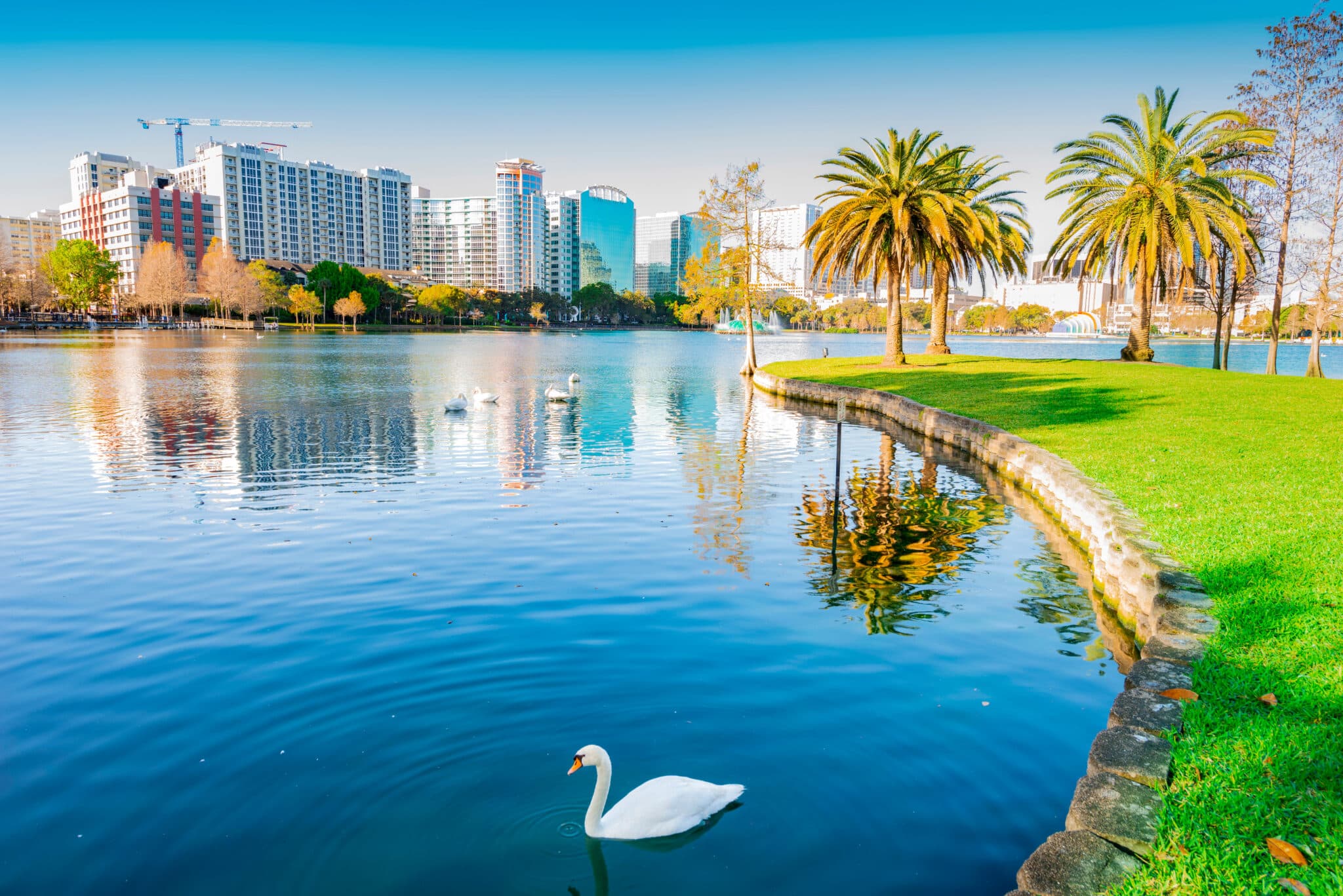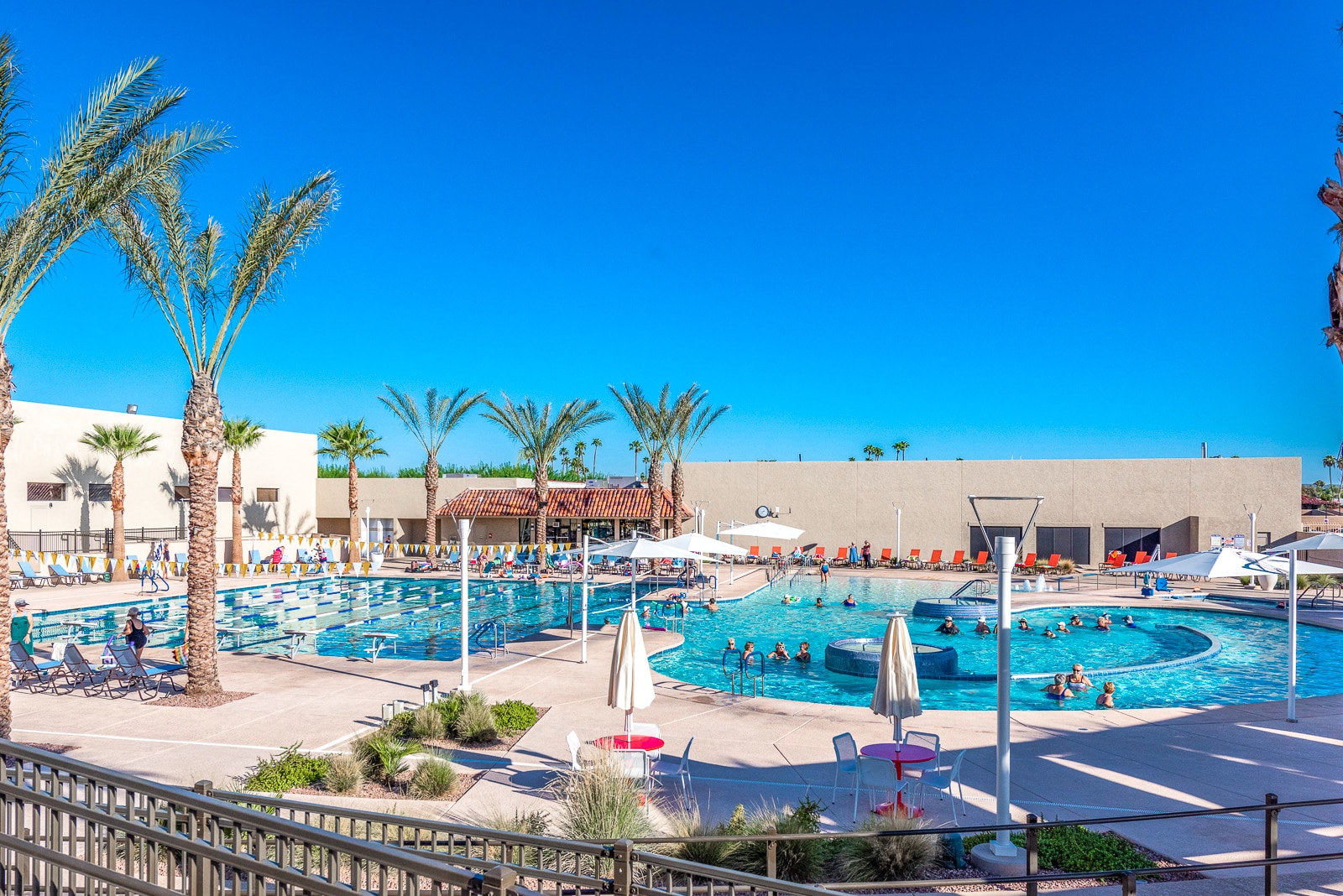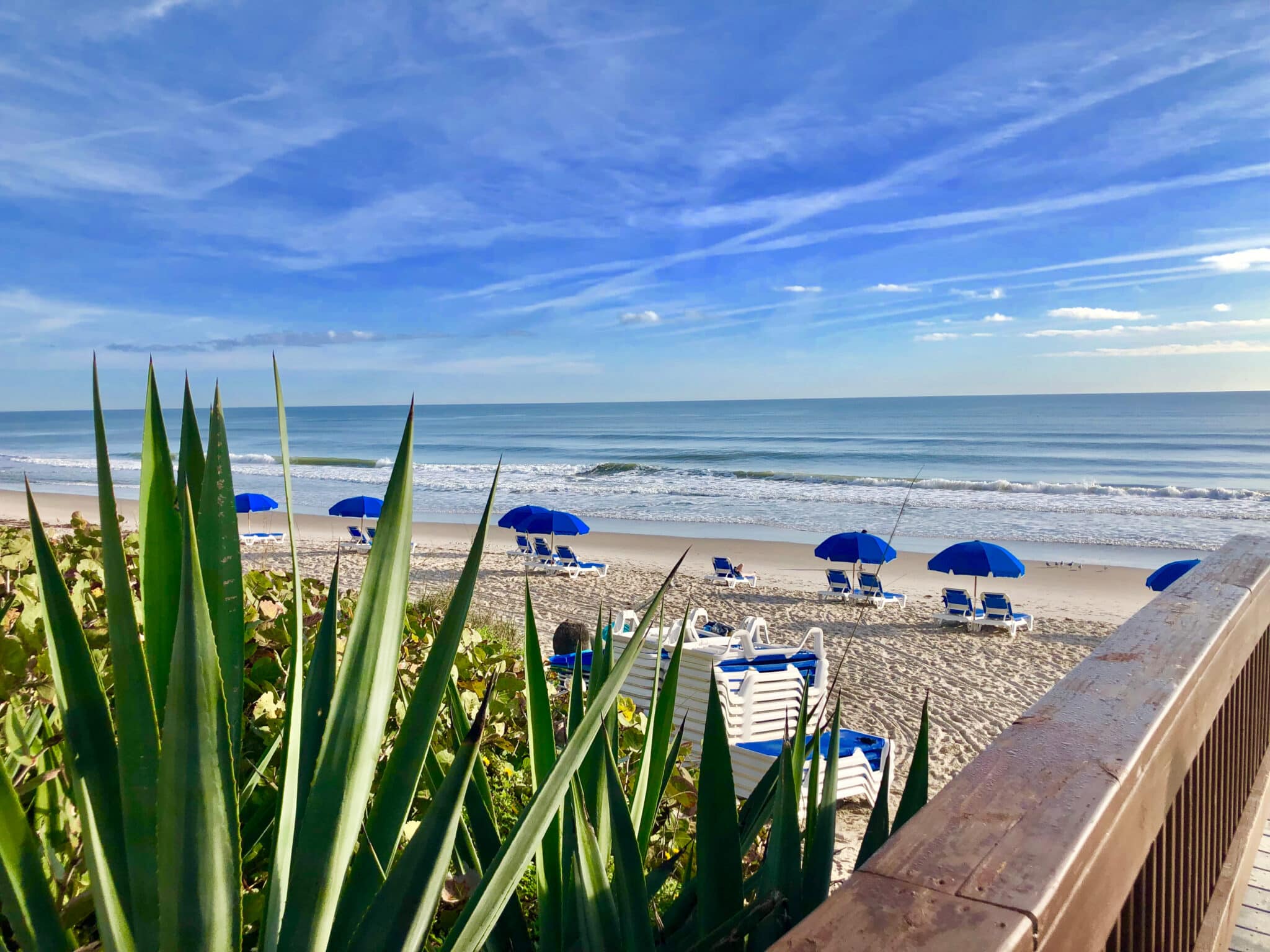While plenty of retirees are flocking to both the Atlantic and Gulf coasts, there’s a growing number of active adults who are thinking outside of Florida’s crowded seashores and moving into the central part of the state. Cities like Orlando are experiencing growth in both population and opportunities. Outside of Orlando, communities such as Leesburg, Clermont, The Villages, and Winter Garden are seen as ideal spots for outdoor recreation, local entertainment, and easy access to some of Florida’s larger cities.
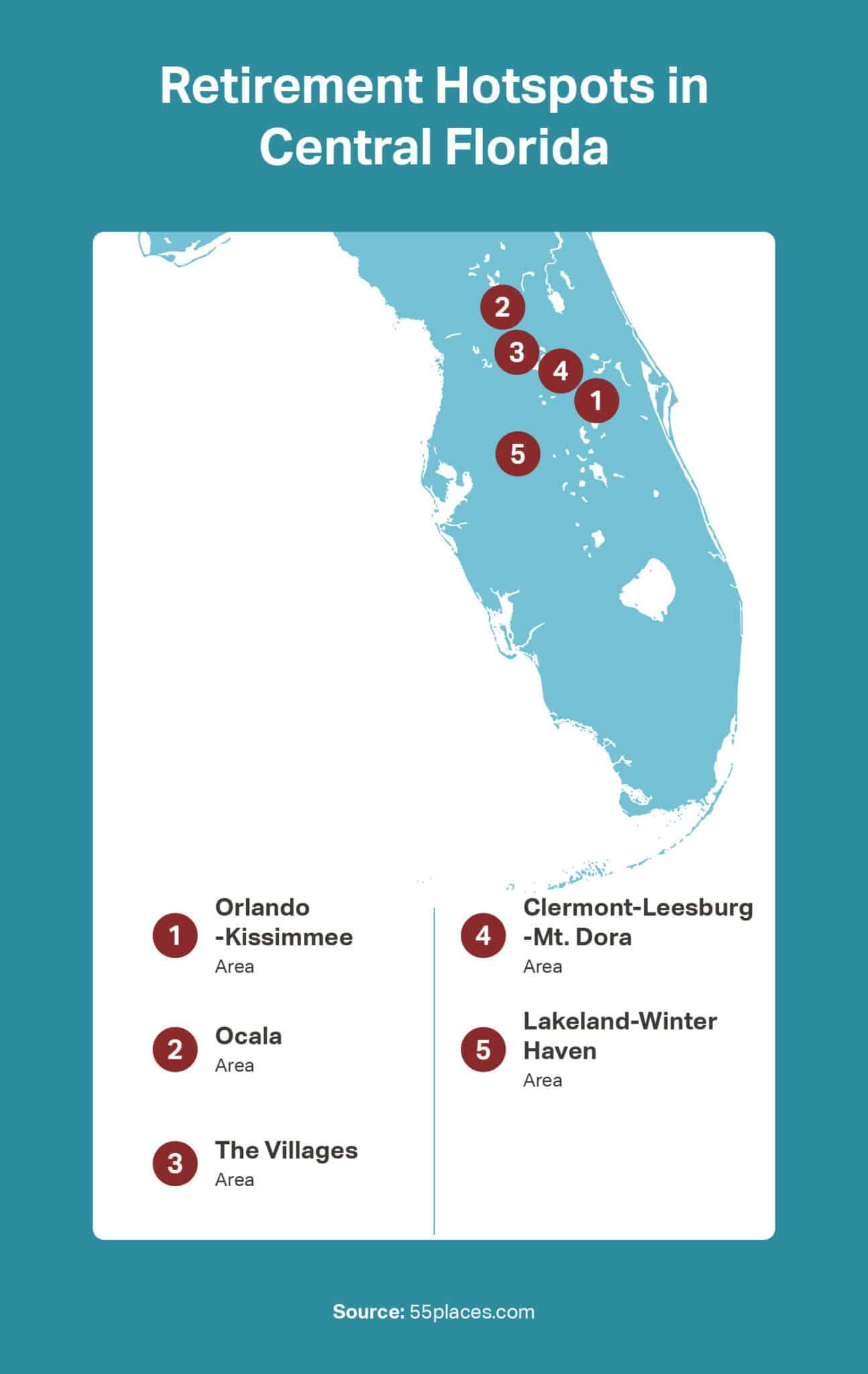
A Snapshot of Central Florida
Central Florida is a viable option because it’s often more affordable than coastal cities. It offers a relaxed, active lifestyle that typically includes golf, tennis, and pickleball, as well as fine and casual dining, good shopping, and, of course, entertainment. Retirement communities in Central Florida are conveniently located near theme parks, art museums, universities, and arenas that host a variety of events, including live music and professional sports.
Many of the best cities to retire in Central Florida are also greener, boasting an abundance of parks, forests, trails, lakes, rivers, and springs. Airboat rides allow for wildlife photography and birding. Hiking is popular, as well as biking and horseback riding. Towns like Mount Dora, Tavares, and Winter Park offer outdoor festivals, boating, and antique shopping. Ocala is known for its picturesque horse farms and the famous World Equestrian Center.
We’ve put together this guide to your Central Florida retirement so that you have all the information and resources you need to plan where you’ll live, what you’ll do, and how to prepare for everything from weather to taxes to health care. You’ll find helpful information in this guide whether you’re a snowbird planning to spend part of the year in Florida, a current retiree seeking a permanent place to live, or an active adult thinking about retirement in the next few years.
What It’s Like to Retire in Central Florida
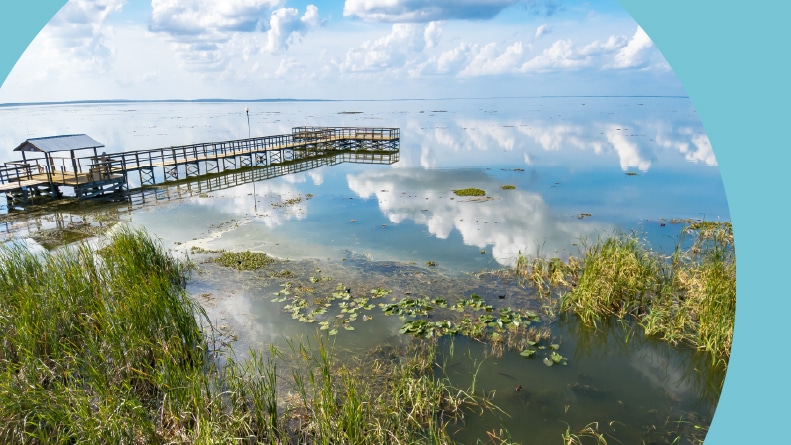
Centrally located, retirement communities in Central Florida offer access to both coasts. Residents can get to the warm, calm Gulf waters in Tampa and Clearwater or the big waves of the Atlantic in Cocoa Beach and Ormond Beach within two hours. Highways including Interstate 4, Interstate 75, and The Florida Turnpike keep central cities connected to major Florida cities like Tallahassee, Jacksonville, Tampa, Daytona Beach, Naples, and Miami. International airports are accessible from the center part of the state, too, specifically Orlando International Airport, Orlando Sanford International Airport, and Tampa International Airport.
“Central Florida strikes the perfect balance. Close to world-famous attractions and health care hubs, but filled with quiet towns where retirees can enjoy a slower pace of life.”
-Khadeejah Johnson, Associate Vice President of Brokerage & Partnerships at 55places.com
Outdoor Activities in Central Florida
- Biking and hiking trails in Ocala National Forest and along The Florida Trail
- Fishing, kayaking, paddleboarding, and boating on freshwater lakes
- Over 8,000 lakes in Florida, many in Central Florida, including Lake Apopka and The Butler Chain of Lakes
- Nature preserves with trails, boardwalks, educational centers, and wildlife
- Popular state parks such as Wekiwa Springs and Lake Louisa State Park for nature walks, birding, and camping
Family-Friendly Entertainment in Central Florida
Major theme parks in and around Orlando:
Additional family-oriented attractions:
Climate and Weather
Warm weather is enjoyed year-round, and the seasons are more distinct than they are in southern cities like Miami. There’s even some change in leaf color, although it’s nothing like autumn in the northern states. Without coastal breezes coming off the ocean, summer temperatures can feel a bit hotter; however, they cool down quickly as winter approaches. It’s even common for Central Florida residents to turn off the air conditioning and throw open the windows in January and February.
The threat of hurricanes and tropical storms is a lot lower in Central Florida. While there’s always a chance of high winds and drenching rains, there’s never going to be a direct hit in these communities. Even the strongest hurricanes have been on land for several hours by the time they reach the middle of the state, meaning they have slowed and weakened.
It’s hard to avoid the heat and humidity in the summer. Most residents find relief in their well-insulated homes with strong air conditioning. There’s also abundant access to community pools and local lakes. Most residents spend their time outside during the less-intense temperatures, particularly in the early mornings and late evenings.
Additional Resources
- The Best Places To Retire in Florida Without Hurricanes
- Weathering the Storm: Does an HOA Cover Hurricane Damage?
- The Most Affordable Places to Snowbird in Florida
- Fresh Alternatives to Florida for Retirement
Cultural & Recreational Appeal
Depending on the city you choose for your Central Florida retirement, there will be a diverse selection of things to do. Active adults can have fun at any of the popular theme parks in the Orlando area, and there are also interesting theaters and museums, such as:
Dining
Residents have access to Michelin-starred restaurants, such as Foreigner Restaurant, which offers a 10-course dinner. They can also enjoy international cuisine, such as that at The Floribbean Grill, which combines Latin American and Southern flavors. Additionally, there are casual local eateries, such as Hunger Street Tacos, which offers a daily taco special.
Festivals
For active adults who love live music and the festival scene, there are a few good ones to check out in Central Florida. Mount Dora is especially known for its calendar of festivals, including:
- Mount Dora Arts Festival (January)
- Mount Dora Magic Bash (September)
- Mount Dora Bicycle Festival (October)
- Mount Dora Craft Fair (October)
- Mount Dora Plant & Garden Fair (November)
- Central Florida Film Festival (January)
In Winter Garden, April is a significant month, featuring the Spring Fever Festival and the Winter Garden Music Festival, which are held annually. Every Friday night, there’s live music in The Plaza, and a farmers’ market is held every Saturday.
Water Recreation
People in Central Florida love their time on the water. Boating and fishing are cherished pastimes, whether it’s casting a line from the shore or setting out on a pontoon. The region offers numerous boat launches and access points for kayaks, paddleboards, and canoes on its many inland lakes and winding rivers.
For those who enjoy a more adventurous outing, guided airboat tours in Kissimmee and Apopka provide an up-close look at Florida’s unique wetlands and wildlife, including alligators, herons, and other native species. With numerous opportunities, from a peaceful paddle at sunrise to an exhilarating ride across the marshes, water recreation is truly at the heart of Central Florida living.
What Are the Pros & Cons to Central Florida Retirement?
In Central Florida, active adults and retirees will find more affordable housing, especially compared to pricey cities on the coasts. The weather, while hot in the summers, is more seasonal than other parts of Florida, and it’s also more predictable. There’s no coastal storm surge risk (which also means insurance rates are lower), and while tropical weather is always possible, it’s unlikely to be as damaging as it can be in cities on the Gulf Coast or up and down the Atlantic side of the state. Plus, Central Florida cities offer easy travel access and a lot of fun.
The major drawback to living in Central Florida, of course, is that there’s no immediate access to the sand and saltwater of this state’s famous oceans. A beach day will mean a two-hour drive. There’s also some growing traffic in the Orlando metropolitan area, and moving through the city on I-4 can feel pretty painful, especially during rush hour. A lot of suburban communities aren’t very walkable, and public transportation is minimal, making a car necessary.
Additional Resources
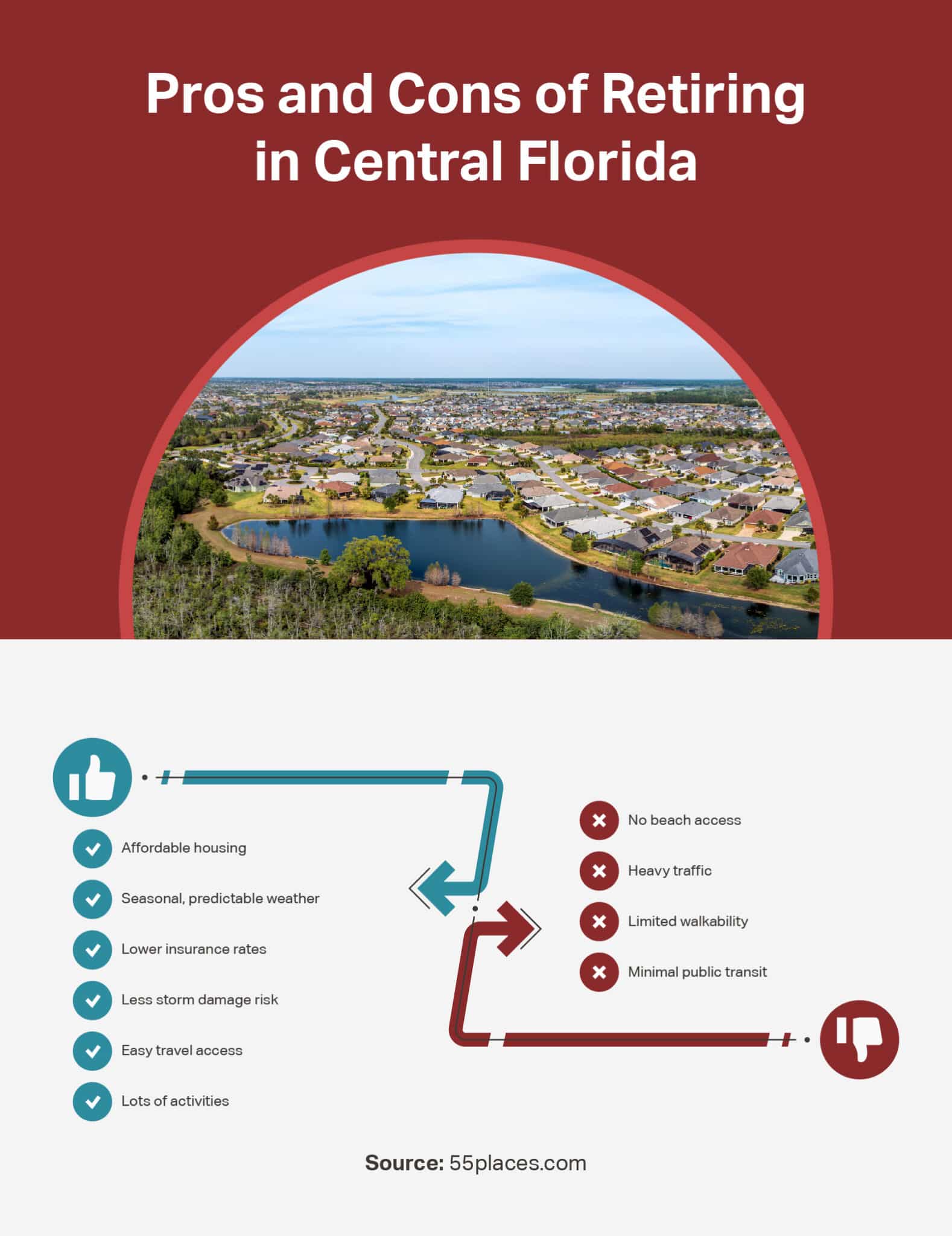
Best Places to Retire in Central Florida
Central Florida spans several counties, cities, and communities. Here are some of the top destinations, and some information on the retirement communities in Central Florida that might be right for you.
Orlando Metro Area (Orlando, Winter Park, Lake Nona)
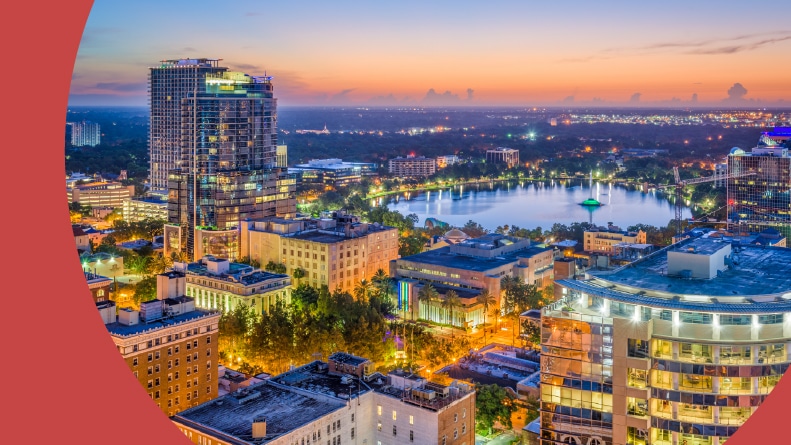
Orlando is the largest city in Florida’s central region. It’s an easy choice for active adults who want easy access to world-class health care and conveniences such as large retailers, grocery stores, and transportation hubs.
Orlando and neighborhoods such as Winter Park, Lake Nona, and St. Cloud offer an energetic, urban environment with great food, shopping, and fun. A lot of the local neighborhoods are walkable. If you anticipate visits from children and grandchildren, there’s an endless list of things to do. The theme parks are renowned, and there’s a lot of nature and recreation that’s family-friendly and available year-round. This is the place to be when you’re anticipating a steady stream of visitors, and you want to keep them happy and entertained.
Here are some additional benefits of living in Orlando and its suburbs:
Health Care
- Award-Winning Hospitals: diverse specialties and extensive medical staff
- Orlando VA Medical Center: a highly rated facility serving veterans
Arts & Culture
- The Plaza Live: one of Orlando’s oldest theaters
- Hard Rock Cafe Orlando: iconic music and dining venue
- Dr. Phillips Center for the Performing Arts: Broadway shows, concerts, and more
Travel & Transportation
- Florida Interstates and Turnpikes: Convenient access to destinations across the state
- Orlando International Airport: one of the nation’s largest, with domestic and international flights to Europe, Asia, and South America
- Brightline: high-speed rail for easy travel to South Florida without driving
Housing Options
Downtown Orlando offers condos and luxury apartments that provide immediate access to everything the city has to offer. These are low-maintenance homes, where residents don’t have to worry about home improvement projects and landscaping. Winter Park is well known for its condo communities too, and there are some especially interesting new construction communities. This is ideal for residents who want to choose their own finishes and designs before moving in.
Homebuyers will find a collection of master-planned communities in Lake Nona, featuring high-end amenities such as golf courses, fitness centers, and pools, as well as a vibrant social calendar of events, activities, and excursions. Many of those developments have secure neighborhoods that are age-restricted, preserving the 55+ lifestyle.
Additional Resources
- Is Orlando a Good Place to Retire? What You Need to Know
- 55+ Communities With Golf Courses in Orlando
- Orlando, Florida 55+ Communities With Their Own Restaurants
- 55+ Communities in Orlando, Florida
- 55+ Communities With Condos for Sale Near Orlando
- Tampa vs. Orlando: Which Is Better For Your Retirement?
- Orlando vs. Miami: Which Is Better for Your Retirement?
- Jacksonville vs. Orlando: Which Is Better for Your Retirement?
- Moving to Orlando? Here’s Everything Retirees Need to Know
- Solivita vs. Del Webb Orlando
Ocala & Marion County
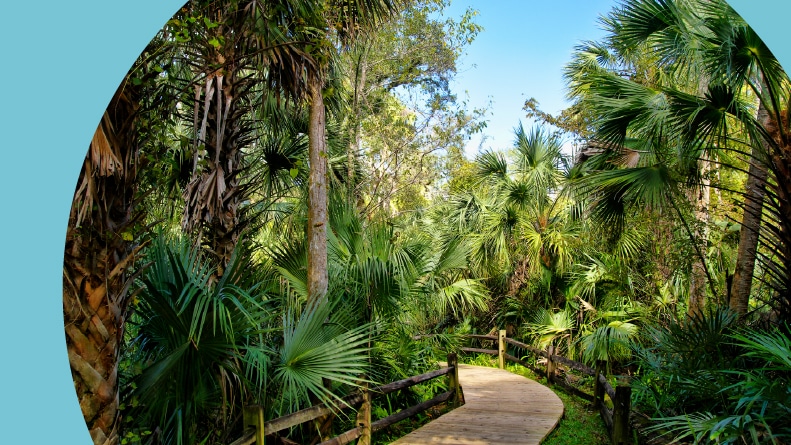
Located just a short distance from Orlando and less than 100 miles from Tampa, Ocala is situated in Marion County. Gainesville and the University of Florida are less than an hour away from Ocala, and this is one of the best cities to retire in Central Florida if you happen to love horses. The area is rich in rolling hillsides, open land, large oak trees, and picturesque horse farms with lovely animals grazing in deep green fields.
In Ocala and throughout Marion County, areas like Dunnellon, Belleview, and Reddick offer active adults less traffic, fewer people, and a more relaxed pace of life. Ocala has grown significantly, offering many of the amenities found in larger cities. There’s a notable art museum at the College of Central Florida, Appleton Museum of Art, and a lot of restaurants and shopping opportunities. Outside of Ocala, forests, springs, and equestrian stables abound.
Because the population of Ocala has grown significantly over the last decade, services have had to rush to catch up. There’s a great health care system and a strong sense of community that takes residents back to “Old Florida,” a term used by local historians and generational fixtures who remember Central Florida before development, air conditioning, and tourism.
Equestrian Life in Central Florida
Here’s why Ocala is called the Horse Capital of the World:
- World Equestrian Center (WEC): Largest equestrian complex in the U.S., featuring horse shows, shops, restaurants, a hotel, and a dazzling holiday lights display
- Florida Horse Park: 500-acre facility hosting horse shows, polo, agricultural events, holiday light shows, and offering camping opportunities
- Marion County: Home to more than 1,200 horse farms, a central part of the region’s culture
- Triple Crown Winners: Affirmed, the 1978 Triple Crown Winner, was born and trained in Ocala; Marion County is also connected to American Pharoah, who won in 2015
Housing Options
Many popular 55+ communities can be found in this area, including On Top of the World, which has 10,000 homes in single-family and attached models. Additionally, Stone Creek is a desirable and gated 55+ community featuring a stunning pool, numerous amenities, and an onsite activities director. Many retirees choose Ocala and its surrounding areas because they find more affordable homes compared to those in major metropolitan areas.
Additional Resources
The Villages
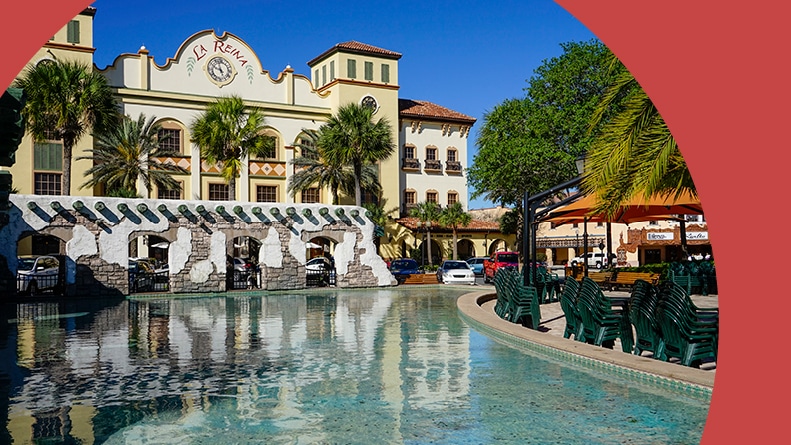
It’s impossible to talk about retirement communities in Central Florida without talking about The Villages. This is one of the largest and most well-known retirement communities in the U.S. It covers three Florida counties, four zip codes, and 70,000 homes. The 55+ community offers single-family homes, attached villas, and condos. For many retirees, The Villages offers a unique lifestyle that encapsulates everything they desire in retirement.
Here are some additional benefits of living in this expansive community in Central Florida:
- Golf Cart-Friendly Design: connected neighborhoods, districts, and town squares; individual villages include Hemingway, Bonita, and Monarch Grove
- Nonstop Activities: live music, farmers markets, fitness classes, book clubs, and golf tournaments foster strong community connections
- Convenient Health Care Access: local urgent care centers, medical facilities, and emergency departments
Active Adult Lifestyle
Residents choose their homes based on where they want to be, what kind of amenities they want nearby, and which part of this sprawling community is most appealing. In some neighborhoods, there’s a woodworking shop. In other neighborhoods, birdwatchers gather to check out the wintering birds that arrive in the local ponds. There are neighborhoods close to retailers and grocery stores, condos that are right off of town squares, and villas that include screened porches. All of the homes in The Villages are low-maintenance, and plenty of residents travel for long periods throughout the year, knowing their home is secure.
Housing Options
Many of the homes at The Villages have custom upgrades. Imagine wine cellars and concrete floors. While pools are abundant in each neighborhood, some homes have private pools. Additionally, The Villages boasts more than 70 golf courses, making it easy to choose a home with a golf course view.
With so many properties and so many neighborhoods, there’s a real diversity of options. This is not the place to be if you’re looking for a small and intimate neighborhood where you know all of your neighbors. The Villages will best serve active adults who are ready to expand their network, meet new people, and try new things.
Additional Resources
- 20 Communities Similar to The Villages Across the U.S.
- The Villages vs. On Top of the World
- 10 Myths and Rumors About The Villages
Leesburg, Clermont, & Mount Dora
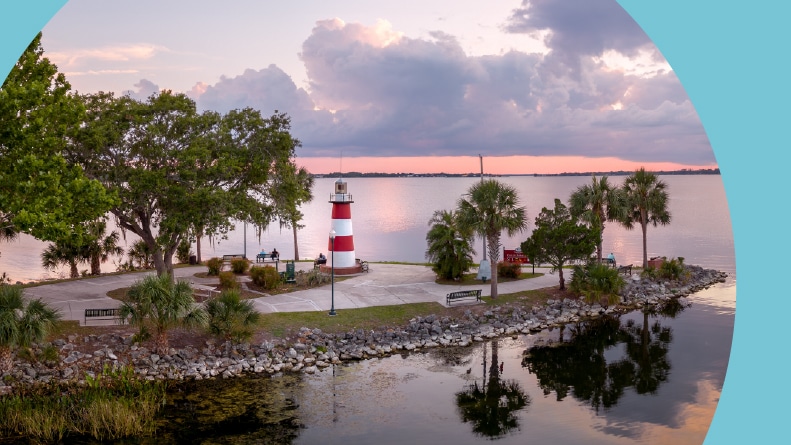
Moving outside of the more well-known areas of Central Florida, it’s time to consider the quiet communities in places like Leesburg, Clermont, and Mount Dora. Here, residents enjoy history and antiques. There are small local libraries that chronicle the history of how these small, charming communities came to be. Additionally, all of these communities are walkable and feature a variety of local art galleries, boutiques, and antique shops. Local cafes provide outdoor seating and ongoing events.
Mount Dora
In Mount Dora, there are waterfront promenades along the lake, regattas in the spring, and a number of marinas, docks, and launch points throughout the Harris Chain of Lakes. In recent years, Florida’s Fish and Wildlife Commission (FWC) has installed numerous fish attractors on lakes within the Harris Chain, making this part of Central Florida a great place to fish and look for wildlife.
Leesburg
In Leesburg, the annual Bike Fest is a fun opportunity to mingle with hundreds of thousands of participants and take a look at the latest motorcycles and riding gear. The city is also home to Venetian Gardens, which features boardwalk walking paths, a diverse bird and duck population, and a lovely lake ideal for boating and kayaking.
Clermont
Clermont is quickly becoming one of Central Florida’s most desirable destinations, known for its picturesque rolling hills and pristine lakes such as Lake Minneola. The city has built a strong reputation for health, wellness, and fitness, with numerous biking and walking trails, including the scenic South Lake Trail. Its vibrant downtown area blends charm and activity, featuring locally owned shops, craft breweries, restaurants, and a variety of community events.
Housing Options
When it comes to choosing where to live, active adults will find quaint cottages and historic homes near downtown areas. There are also a growing number of newer subdivisions and small communities near the lakes. Buyers can find communities with waterfront views and access to docks and launches.
Additional Resources
- 7 Popular Gated Communities in Florida’s Clermont-Leesburg Area
- The Best Golf Course Communities in the Clermont and Mt. Dora Area
- The Best Lowest-Priced Communities in Leesburg, Florida
- The Best 55+ Communities in Leesburg, FL for Staying Active
Lakeland & Polk County (Davenport, Haines City, Winter Haven)
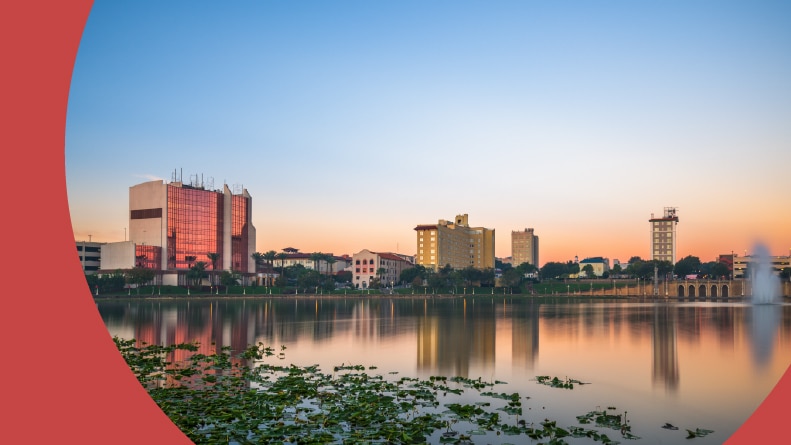
Moving west from Orlando and in the direction of Tampa, we find Lakeland. This city is more affordable than Orlando or Tampa, and provides a lower cost of living and a fantastic quality of life. Downtown Lakeland is full of art, culture, and book fairs. There are also some lovely lakes, some of which are populated with swans that descend from the swans given as gifts from the Queen of England a hundred years ago. There are also a lot of trails and hiking spots throughout Lakeland, Davenport, Haines City, and Winter Haven.
Some of the things that people love about this part of Central Florida:
- Arts & Culture in Lakeland: Polk Museum of Art, Notta Gallery, Melvin & Burks Galleries, Frank Lloyd Wright architecture at Florida Southern College, Polk Theatre, and Florida Children’s Museum
- Golf in Davenport: Premier courses like Providence Golf Club and ChampionsGate Golf Club
- Community Parks: In Haines City, Lake Eva Park is the spot for outdoor movie nights, concerts, farmers’ markets, and recreational facilities
- Winter Haven Chain of Lakes: 50 interconnected lakes for boating and fishing
- Low Tourism: Quieter communities compared to Orlando
Housing Options
For housing options, there’s a large selection of well-appointed 55+ communities, including popular neighborhoods like Del Webb Orlando in Davenport, which is a gated community of single-family homes known for its many amenities. There’s also Solivita in Kissimmee, one of the most sought-after retirement communities in central Florida, with a golf course, pickleball, private lakes and waterways, and more than 20 models of homes for buyers to choose from.
Additional Resources
- Lakeland Area 55+ Communities With Homes for Sale Under $200k
- 55+ Communities With Homes for Sale Under $150k in Lakeland and Winter Haven
Additional Central Florida Resources
- Central Florida Communities With No Age Restrictions
- The Best Retirement Communities in the Florida Panhandle
- South Carolina vs Florida: Which Is Better for Retirement?
- Georgia vs Florida: Which Is Better for Retirement?
- Is It Better to Retire to Florida or North Carolina?
- Best Beach Retirement Towns in Florida: Find Your Ideal Spot
- Is It Better to Retire on the East or West Coast of Florida?
- Arizona vs. Florida: Which Retirement Destination Is Right for You?
Housing in Central Florida: Options, Costs & Communities
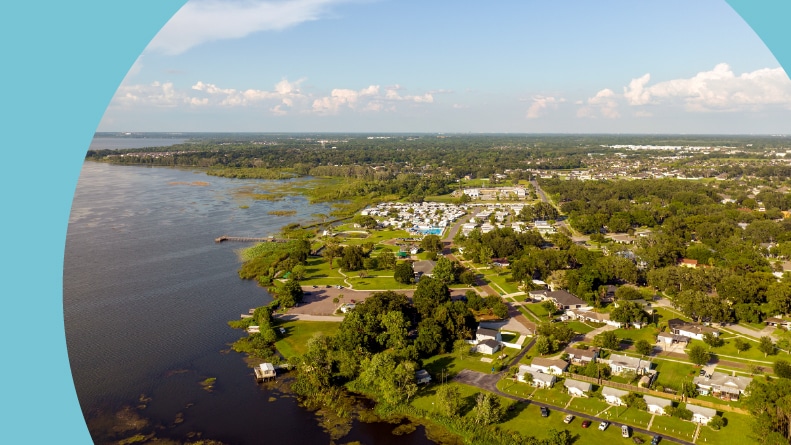
Retiring to Central Florida is one decision easily made, but choosing the best housing type for your lifestyle and budget is the next big decision. Do you value the space and privacy of a single-family home? Would you prefer an intimate community, a new construction property, a country club vibe? Will you rent before you buy? Let’s review the options.
55+ and Active Adult Communities
One of the most popular choices for active adults is a 55+ community. These age-restricted neighborhoods are especially easy to find in Leesburg and Clermont. Additionally, there are some excellent options available in and around Ocala, as well as in communities throughout Orlando and Lake Nona. Some of the reasons why retirees choose a 55+ community include:
- Low-maintenance living: HOAs often handle landscaping, lawn care, trash, water, and even cable/internet.
- Social opportunities: Lifestyle directors, clubs, classes, and sports like pickleball and tennis keep residents active and connected.
- Age-restricted environment: Quiet, peer-focused living among like-minded adults without the noise of young children.
- Enhanced safety: Many communities are gated and some provide 24-hour security.
- Resort-style amenities: Pools, fitness centers, walking trails, gardens, and gathering spaces promote a high quality of life.
55+ communities offer a wide range of options, from spacious single-family homes with open layouts and modern upgrades to low-maintenance condos in high-rises or garden-style buildings, as well as attached villas and even manufactured homes.
Master-Planned and Resort-Style Living
Sometimes, 55+ neighborhoods are located within a larger master-planned community. This can offer some additional benefits to residents, including expanded amenity options, town centers that feature grocery stores, banks, restaurants, and retailers, as well as numerous onsite recreational facilities. Many master-planned communities also feature multiple golf courses, and golf carts are often the preferred mode of transportation.
A master-planned community also offers some flexibility for residents who want the structure of a 55+ community but prefer not to be restricted by age. Perhaps you’re retiring to Florida with your adult children, who plan to live with you. Maybe you’ll have some grandkids coming too. That’s an excellent reason to choose a master-planned community. Not only is it easy to find one without age restrictions, but they’re also likely to be located in excellent school districts.
Where might you find some 55+ neighborhoods in master-planned communities in Central Florida? Notable examples are:
- Cormorant Point – Sebring, FL
- Del Webb Orlando – Davenport, FL
- Gatherings of Lake Nona – Orlando, FL
- Oak Run – Ocala, FL
- Palms at Serenoa – Clermont, FL
- Solivita – Kissimmee, FL
- Terra Vista – Hernando, FL
- The Lakes at Harmony – Harmony, FL
- The Villages – The Villages, FL
- Tohoqua Reserve – Kissimmee, FL
- VillageWalk at Lake Nona – Orlando, FL
Additional Resources
New Construction vs. Resale
There’s also a decision to be made about new construction homes and resale homes. Central Florida has experienced significant growth over the past few years. For that reason, new construction inventory is widely available throughout the region.
Benefits of New Construction Homes
- New construction homes are modern and updated. There are likely to be stainless steel appliances, quartz or granite countertops, and modern layouts and floor plans.
- Buyers appreciate energy-efficient designs and smart home technology that make daily living more convenient.
- New construction homebuyers may have the option to customize their new home before construction is complete.
- Builder incentives are often included, such as help with closing costs and free upgrades.
However, that doesn’t mean new construction is for everyone. In some situations, active adult buyers will feel a resale home is more advantageous.
Benefits of Resale Homes
- Costs for new construction homes are often higher. When you’re comparing price per square foot for a new construction home against the price per square foot for a resale home, you might find that the resale home is more budget-friendly.
- There’s a neighborhood consideration, too. Because new construction communities require a lot of space, they’re often located outside of more developed areas.
- Resale homes are typically located in established neighborhoods and feature mature landscaping. There’s not a lot of noise from ongoing construction in the immediate area.
There are numerous pros and cons to consider when comparing new construction and resale homes. Decide whether you want a move-in-ready home or if you’re willing to make some updates to an older home. Consider what you envision for your neighborhood, and how flexible you are regarding price and design details.
Additional Resources
Home Prices and Rents by Area
Florida is one of the top snowbird destinations in the U.S., which means the market is competitive and demand is high. That doesn’t have to scare a retiree off, however. While prices have risen in the last few years, Central Florida cities offer a lot more affordability than coastal cities.
“What sets Central Florida apart is its relative affordability compared to coastal markets. Retirees find they can stretch their budgets further, whether that means purchasing a home in a 55+ community or enjoying more of the lifestyle experiences they’ve worked hard for.”
Rental Options
If you’re planning to rent, you have several options for structuring lease agreements and finding well-maintained, high-quality rental properties. Consider the following:
- Seasonal rentals are popular in Central Florida: Many snowbirds come from October through April, and renters will find plenty of options during those months.
- Condos and apartments dominate the seasonal market: Short-term vacation rentals are available, and with Florida’s flexible rental laws, supply generally meets demand.
- 55+ communities often offer flexible leases: Options typically include three-, six-, or 12-month terms.
- Renting is a smart first step: If you plan to retire in Central Florida but aren’t sure where to buy, renting helps you explore towns, neighborhoods, and housing types, from single-family homes to new construction and waterfront condos.
55+ Home Prices
The money matters, so let’s compare median home prices in some of the most popular Central Florida metro areas. According to data from 55places.com, the median price of a home in a 55+ community in Central Florida is $350,000. However, prices are always going to vary, depending on factors like:
- Age of the home
- Proximity to water
- Amenities, such as golf courses and boat docks
- Community type
Most active adults will work out a detailed budget before they start shopping for retirement homes. In addition to the purchase price, you’ll want to factor in your insurance costs, your property taxes, and potential HOA fees.
“We’ve seen growing interest from retirees nationwide who want an affordable alternative to coastal Florida. Central Florida’s 55+ communities are thriving as a result.”
-Bill Ness, Chief Executive Officer, Founder, & Illinois Managing Broker at 55places.com
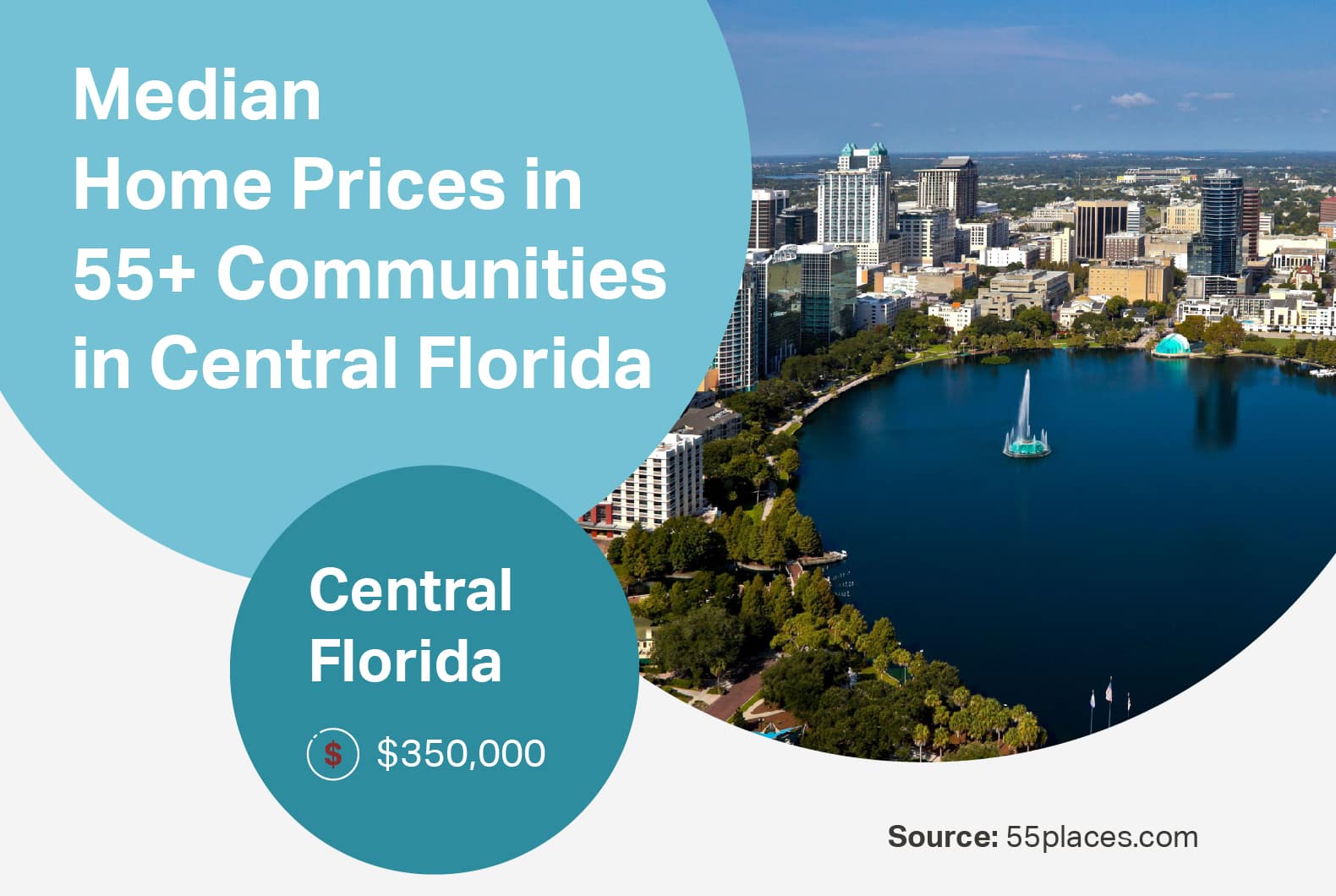
Flood Zones and Insurance Considerations
Insurance costs, although significantly lower in Central Florida than on the coast, are still rising. According to The Orlando Sentinel, this is due to many reasons:
- Inflation: Everything everywhere is more expensive, and you have surely noticed that.
- High Reinsurance Costs: The busy hurricane seasons of the last five years have resulted in billions of dollars in claims being paid out. The cost of reinsurance, which is insurance for insurers, has exploded, and those increases have been passed on to consumers.
- Fraud: Roofing scams, unfounded lawsuits, and inflated claims contributed to higher insurance costs. Fortunately, new laws have mitigated this risk for both insurers and consumers.
- Stronger Storms: Central Florida counties have a different risk profile compared to Miami or Tampa. Still, as storms intensify, wind and rain can cause expensive problems for homeowners throughout the state, which in turn raises premiums.
Flood Insurance
Flood insurance is becoming a good idea, even if it’s not required for your property’s zoning. Certain areas, particularly those near lakes and rivers, are designated as Special Flood Hazard Areas (SFHAs). This makes flood insurance legally required. Purchasing flood insurance might be a good way to protect your property and your own finances from debilitating losses.
Prepared for Hurricanes and Tropical Storms
Keep insurance costs lower by showing you’re prepared for hurricanes and tropical storms. Wind-resistant windows, for example, and hurricane shutters can reduce rates and protect your home. Local building codes in Central Florida require homes to be elevated based on the Base Flood Elevation (BFE) and the Design Flood Elevation (DFE), ensuring that the lowest floor of a building is at least one foot above the DFE.
As we’ve said before, Central Florida communities will never be a direct hit, but the impacts of a significant storm will still be felt. Anyone living inland faces a lower flood risk, but there is still a risk of flooding. Check with your HOA about any preparations or insurance coverage that may be required.
Insurance costs in Central Florida have risen, but it’s even worse for coastal retirement areas. The average annual cost of property insurance in cities like Orlando and Gainesville is around $3,000, compared to an average cost of $5,800 in Miami-Dade County, according to Florida Realty Marketplace.
Additional Resources
- Benefits of an HOA: Why 55+ Homebuyers Want a Homeowners’ Association
- Buying a Home With or Without an HOA
- Everything You Need to Know About a 55+ Community HOA
- Homeowners Insurance for Seniors: A Comprehensive Guide
- Understanding Florida Homeowners Insurance: What to Expect and How to Prepare
Cost of Living, Health Care & Local Services
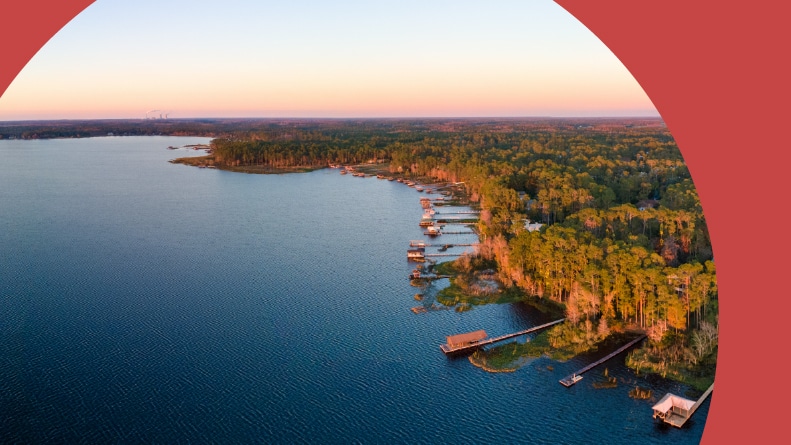
The cost of living in Central Florida is lower than it is in most coastal areas of the state. Whether we’re talking about housing, utilities, entertainment, transportation, or groceries, retirees here pay less for everyday items than those in coastal cities.
Cost of Living Comparison
The cost of living in Central Florida is lower than it is in most coastal areas of the state. Whether we’re talking about housing, utilities, entertainment, transportation, or groceries, retirees here pay less for everyday items than those in coastal cities. Cities like Orlando are more expensive than suburban areas, and areas like Ocala and The Villages offer a bargain for active adults. Here’s a breakdown of the cost of living in Central Florida:
- Orlando: 6.0% higher than the U.S. average; 2.8% lower than the state average
- Ocala: 13.0% lower than the U.S. average; 15.6% lower than the state average
- The Villages: 2.1% lower than the U.S. average; 5.0% lower than the state average
- Lake County: (Leesburg, Clermont, and Mount Dora) 0.7% higher than the U.S. average; 2.3% higher than the state average
- Lakeland: 8.4% lower than the U.S. average; 11.2% lower than the state average
Additional Resources
- How Much Does It Cost to Retire in Florida?
- Understanding Florida Homeowners Insurance: Where to Expect and How to Prepare
- Can I Retire in Florida on $3,000 a Month?
- How Long Will $1 million Last in Retirement in Florida?
- Social Security Changes for Florida Retirees in 2025
- Best Places to Retire in Florida on a Budget
- Luxury Retirement Communities Florida
- 55+ Communities in Florida Under $100,000 With Homes for Sale
- Best Lowest-Priced Communities in Florida (With Low HOA Fees)
Health Care Access
An excellent network of health care systems, hospitals, and medical centers keeps active adult residents in Central Florida healthy.
Orlando Health is recognized for its numerous locations across Central Florida, its 180 practicing physicians, and its ranking as the fifth-best hospital in the state, according to U.S. News. Also, the health system boasts the only Level One Trauma Center in Central Florida, located at Orlando Health ORMC. Orlando Health is known for its expertise in:
- Cardiology
- Neurosciences
- Orthopedics
- Digestive health
- Trauma care
- Bariatric surgery
The best-ranked hospital in the state is AdventHealth in Orlando. This hospital system has been in operation since 1908 and is particularly well-regarded for its emergency services. Additional areas of specialization include:
- Cardiology
- Gastroenterology
- Orthopedics
- Geriatrics
- Pulmonology
- Urology
Additionally, VA Orlando is a five-star-rated facility that provides care to veterans in the Central Florida area. Clinics are in Clermont, Tavares, Kissimmee, and other locations.
Medicare for Florida Residents
Medicare Advantage is widely available to retirees in Central Florida. These plans vary by county, and all Medicare-eligible residents have access to at least one plan with a $0 monthly premium, regardless of their location. Florida has the second-largest Medicare population in the U.S., and over half of the state’s Medicare beneficiaries are enrolled in MA plans. Here’s a glimpse at the kind of availability to expect:
- 54 plans available in Orlando and Osceola County
- 52 plans available in Ocala and Marion County
- 40 plans available in Lake County
Use the Medicare.gov planning tool to browse through plans, compare benefits, and look for coverage that fits your budget. Retirees can also use the Medicare website to enroll.
Additional Resources
- 55+ Communities Near the Best Hospitals in Florida for Seniors
- The Best Places to Retire for Health Care
- How Do 55+ Communities Handle Health Care and Emergency Services?
Taxes
One of the best reasons to settle into a Central Florida retirement is that there’s no state income tax. Additionally, Florida residents are exempt from both inheritance tax and estate tax. While federal taxes will still apply, retirees here will retain a larger portion of their earnings.
Property taxes are managed by the Florida Department of Revenue and collected at the county level. This is what property taxes will look like in 2025 across Central Florida, according to SmartAsset.
| County | Median Effective Property Tax Rate | Median Annual Property Tax Payment |
| Osceola County | 1.40% | $3,024 |
| Marion County | 1.04% | $1,725 |
| Polk County | 0.95% | $1,931 |
| Lake County | 1.16% | $2,362 |
Florida Property Tax Exemptions
The Homestead Exemption can reduce property taxes for full-time residents. For retirees, this exemption can result in substantial savings on property taxes. Here’s how it works:
- Basic Exemption: Homeowners can receive a reduction of up to $25,000 in the assessed value of their home for property tax purposes.
- Additional Exemption: A second $25,000 reduction applies to the value of the home exceeding $50,000, but it only applies to non-school taxes (i.e., county and city taxes, not school taxes).
- Senior and Other Special Benefits: Retirees aged 65 and above may be eligible for additional savings, such as the Additional Homestead Exemption for low-income seniors. If your income is below a certain threshold, you might qualify for a larger exemption that can further lower your tax burden.
Additionally, the Save Our Homes (SOH) cap limits how much the taxable value of your homestead can increase each year. It’s capped at 3% annually or the rate of inflation, whichever is lower. This helps protect retirees from sharp increases in property taxes due to rising property values.
For example, on a home that’s assessed at $150,000, an owner can apply the Homestead Exemption, reducing taxable value from $150,000 to $100,000 for non-school taxes, which results in lower county and city taxes. This is just a simplified example, but it shows how the homestead exemption can help reduce property taxes. The actual savings will depend on the specific tax rates in your area, as well as any additional exemptions for which you may qualify.
The counties in Central Florida with the lowest property tax rates include:
- Levy County
- Putnam County
- Suwannee County
- Bradford County
Additional Resources
Is a Central Florida Retirement Right for You?
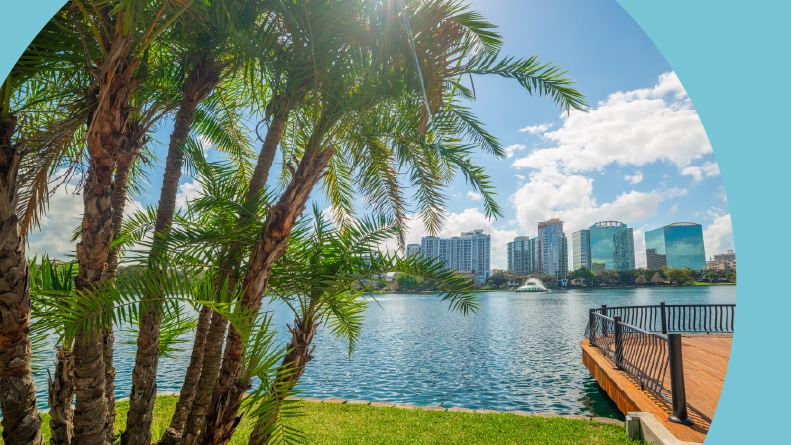
A Central Florida retirement is an excellent idea for many active adults who know their lifestyle and goals will align with what cities and communities in the middle of the state have to offer. For those who long for a retirement on the beach, however, this might not be the place.
Central Florida is an excellent idea if:
- You’re looking for affordability: While home prices and the cost of living have risen all over the state in recent years, Central Florida remains more affordable than many retirement destinations on the Atlantic Coast or the Gulf Coast. It’s also more affordable than the panhandle, and it’s definitely cheaper than Miami or South Florida.
- Insurance costs are a genuine concern: When considering how to protect your property, it’s best to avoid high-risk areas, particularly those prone to flooding and wind damage. Central Florida is not immune to weather-related damage, but the risk is significantly lower than in coastal areas, and insurance premiums reflect this.
- You want access to major attractions, entertainment, and recreation: More than 75 million people visit Orlando alone every year because of the theme parks, the culture, the dining, and the outdoor recreation. Horse enthusiasts want to explore Ocala, and those who love to fish or spend time on their boats head to the lakeside communities throughout Central Florida.
- Good health care is necessary: You might think you have to live in Miami, Jacksonville, or Tampa to access high-quality medical services. Not true. Central Florida offers an abundance of excellent health care options, and most of them are more affordable than those found in larger coastal cities.
Maybe stay away from retirement communities in Central Florida if:
- You really need the sea and salt air: There’s no easy access to saltwater. A beach day will mean a two-hour drive.
- You’re looking for mountains and cooler weather: While Central Florida has some impressive hills, they’re not going to satisfy anyone’s need for elevation changes. And the weather is hot; there’s no way to spin that.
- You want to avoid wildlife: This part of Florida is home to many alligators and even black bears.
Tips for Deciding If Central Florida
Here’s what you can do if you’re still undecided about whether a retirement in Central Florida is right for you:
- Make seasonal visits: We know you’ll love it in January, but consider returning for a week or two in August to experience the heat and humidity.
- Be open to different types of communities: Explore large 55+ communities and master-planned developments, as well as smaller, intimate options to see which one fits you best.
- Consult with retirement experts: At 55places.com, we have a network of local real estate experts who are well-versed in the local Central Florida markets. Connect with one today!
FAQs About Retiring in Central Florida
1. What are the top places to retire in Central Florida?
The most popular retirement destinations in central Florida include Orlando, Lake Nona, Ocala, Leesburg, Clermont, St. Cloud, Mount Dora, Lakeland, Dunnellon, Davenport, and Tavares.
2. How much does it cost to live in Orlando or The Villages?
It depends on whether you’re buying a single-family home in The Villages, renting a seasonal apartment in Orlando, or something in between. Orlando tends to be one of the most expensive places to live in Central Florida, while The Villages offers housing, activities, and amenities that fit a lot of budgets.
3. Is Central Florida more affordable than coastal Florida?
Generally speaking, yes. Central Florida is more affordable because there are fewer people, less tourism (outside of Orlando and its theme parks), lower property insurance prices due to a lower risk of hurricanes and tropical storms, and goods and services, such as groceries and utilities, are generally more affordable.
4. Are there many 55+ communities in Central Florida?
Many 55+ communities can be found in Central Florida, particularly outside of Orlando, as well as in various communities throughout Lake County, Marion County, and Polk County. As demand for active adult living has grown, more communities have emerged.
5. What’s the weather like year-round in Central Florida?
Summers are pretty hot in Central Florida, and there’s no seabreeze to cool things down. However, temperatures in this part of Florida are more seasonal than in cities on the coasts or further south.
6. How accessible is health care in Central Florida?
Health care in Central Florida is excellent, and the area is well-served by award-winning and highly ranked hospitals, such as Orlando Health and AdventHealth Orlando. There’s also a network of VA hospitals and medical clinics throughout this part of the state.
7. Can I find seasonal rentals in Central Florida?
Yes, many 55+ communities and apartment complexes offer homes for rent for one month, three months, or six months. Whether you come for an entire snowbird season or just a few weeks, there’s likely a place to stay that offers amenities and activities.
8. What makes The Villages so popular for retirees?
Retirees love The Villages because it’s an entire community of 55+ neighborhoods that cater to an active adult lifestyle. In addition to offering diverse and comfortable homes, there are hundreds of amenities, including pools, fitness centers, art studios, and pickleball courts. Activities are always encouraged, ranging from outdoor art shows and live music to group trips, fitness classes, and social dinner dances. This is the place to be for active adults seeking new friendships in retirement.
9. Is Central Florida a good place for snowbirds?
Central Florida can be an excellent option for snowbirds who want to spend the winter months in a warm climate with lots to do. Golf in January and outdoor dining in February is available, and the local airports and highways make arriving and departing easy.
10. What are the pros and cons of living inland vs. on the coast in Florida?
Living inland means greater affordability, less traffic and congestion, and a tranquil lifestyle that’s still full of activities and outdoor pursuits. Coastal living means beach vibes and vacation energy, while inland living is more laid-back.
Take the First Step Toward Your Central Florida Retirement
Retirements in Central Florida can be affordable, enjoyable, and filled with new experiences. You get the great weather with seasons that are just a bit more obvious. There’s less tourism and traffic, leaving you to enjoy your home in peace. Most cities and communities in Central Florida are close to Orlando, Tampa, and Daytona Beach. It’s easy to travel around the state from Central Florida, and it’s always satisfying to come home after a day trip or a longer vacation.
Explore the abundance of 55+ communities in this part of the state and find a place that feels like home. If you’d like a bit more direction, feel free to reach out to 55places.com. We can help you find your ideal Central Florida 55+ community today!

